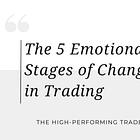Thursday Trader's Tip: Your Self-Management Emergency Plan
Thursday Trader's Tip editions offer quick trading psychology advice that can be digested in 5 minutes.
Mark your calendar!
Our next exclusive webinar for paid members, "Key Differences Between 5- and 7-Figure Traders," will take place on December 14th. If you haven’t reserved your spot yet, secure your spot here.
Watch this edition video at the end of the post.
A common mistake traders make when trying to break toxic behavior patterns?
Inconsistent repetition—and no clear “exit strategy” from that high-emotional state.
Here’s what it normally looks like:
One day, they try journaling.
The next, they give a breathing technique a shot.
And the day after, they’re experimenting with yet another coping method.
The problem?
Hopping from one thing to the next without sticking to anything long enough to see results.
To break a pattern, you need to replace it with a new, consistent pattern.
Trying something different every day won’t cut it.
Instead, you need an emotional management routine you can rely on—one your brain begins to associate with a specific, healthier response to old triggers.
Just like you need solid routines for preparing and executing your trades, you need one for managing yourself.
Here’s my take on what a seven-step emotional management routine should look like:
Recognition — You can use journaling along the session to raise your self-awareness, use alarms at random timings, or identify when things are spiraling by being attentive to a specific trigger occurrence (e.g., after a loss, mistake, or missed trade). Self-awareness is the first step.
Interruption — this is the moment that separates your autopilot from your new response. Saying “STOP” aloud can help you put the necessary brake.
Decision Timer — place your timer for 5-10 minutes to initiate the reframing process.
Acceptance — the first step of reframing is acceptance; here, you want to look inward to identify, validate, and process your thoughts and emotions.
Identify perception distortions — Identify your current perspective distortions of the previous step.
Replacement (facultative) — this can be anything that takes you out of the charts and calms you down. You can go for a walk, do some pushups, do a quick meditation, affirmations, or whatever works best for you!
Emotionally connect with trading principles — when you return to the charts, connect closely with your trading principles and vision. This can also serve as the replacement activity itself.
Your turn!
With the guidance above, build your emotional management routine right now. Click below to download the template:
Defining a routine where you know what you’ll do to self-manage eases its execution in moments when there’s little capacity to think straight.
Disciplined execution starts with planning.
Just like you plan your trading ideas, plan carefully how you’ll manage yourself if those go wrong. That’s the difference between an organized and an undisciplined trader.
Please vote in the poll below if you want me to bring more templates like this.
Peaceful trading,
Sara
P.S. If you took value, tap the ❤️ button and share the post! It’s a small gesture that goes a long way in supporting the continuation of this publication.
Related reads:
Don't miss out on this week's edition in video format:







Great advice
Thanks a lot